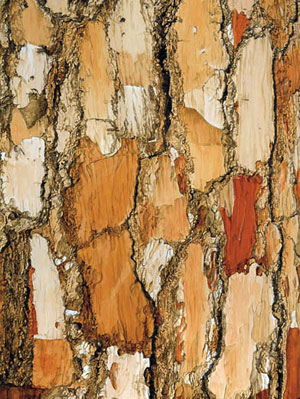“Nature Interrupted”
Artists: Joan Backes (USA), Soazic Guezennec (France), Willy Heeks (USA),
Osmo Rauhala (Finland) & Dannielle Tegeder (USA)
Curated by Elga Wimmer
New Bedford Art Museum - Skylight Gallery
January 28 - May 7, 2006
Opening Reception February 11, 5:30 - 7:30 PM

Joan Backes
"Tree, California"
acrylic on panel
2005
The urgent and important message to restore health to the environment needs to be conveyed in every possible form of media and communication — and art is one of the most powerful languages humans have ever invented. From prehistoric times, people have transformed the environment, shaping their tools from stone, and — in their cave wall paintings, megaliths and stone circles — seeking ways to connect with the force of nature. Since those times, artists and designers have been profoundly influenced by the images, colors, patterns, structures and systems of nature around them. At times of turbulent change in our history — as in Hellenistic Greece, medieval Japan and Europe at the time of industrial and political revolution — new art forms have emerged in order to address the changing relationship between nature and society. Since the turn of the new millennium, world concern has increased over environmental issues such as pollution and global warming, species depletion, new genetic technologies, AIDS, bird flu and foot-and-mouth epidemics. Artists, in turn, are responding by answering collective cultural needs, and developing active and practical roles in environmental and social issues.
In Nature Interrupted, five artists show very diverse aspects of their concern. They may focus on a rare species in danger of extinction, such as the eagle in Osmo Rauhala’s captivating video images, or the preservation of trees threatened by disease, as in Joan Backes’ paintings of tree bark, which could, in the future, become a point of reference to a species no longer in existence. Willy Heeks’s work, even though abstract, is probably the closest to early-century nature paintings, with his layerings of colors and forms that celebrate trees, oceans, earth and skies. Dannielle Tegeder’s drawings depict a certain geometric growth as in the construction of ant colonies or mole hills — it is up to the viewer’s imagination to decide whether Tegeder’s “city” is above or under the ground. Soazic Guezennec transfers the African jungle to a suburban surrounding, embellishing it with colorful billboard images resembling a tree house, giraffe or field of orchids. Art is a potent tool for environmental restoration and we need a lot more of it. Here we have a basis for a true and much needed natural dialogue. I feel it is a silent but determined revolution.
Elga Wimmer
New York, NY
January 2006
New York, NY
January 2006
- Presenting Sponsors
- Joan Underwood
- Frank Lee Barringer & Barry Wing - In Memory of Ryan & Abby
- Exhibit Sponsors
- Tom & Mina Otis
- Chad Michael Peters
- Nancy Crosby
- Dan Perry
- Exhibit Supporters
- Paul J. Arruda Carpentry
- Anonymous Donor
- Reynolds DeWalt Printing
- Dartmouth Building Supply
- Home Depot
- Candleworks Restaurant
- Fiber Optic Center Inc.
- Commercial Drywall & Construction
- Elin Noble/textile artist
- Hannah Haines/mediumstudio